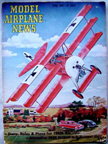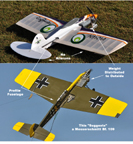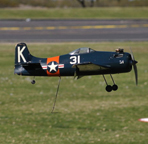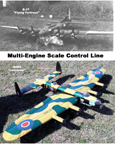April, 1949

Model Airplane News Cover for April, 1949
Scale Control Line
Drawing by Jo Kotula
Click to Enlarge
This is an of a Fokker Dr. 3 Dreidecker (triplane) model made by John Doyle of Andover, Massachusetts. If you look very carefully at the illustration, you'll see two wires coming out of the fuselage just below the middle wing. Those two wires are connected to a handle that John held which could move the elevator to control height (The plane, tethered to the wires, is constrained to move in a circle...)
Briefly, the model is in 1 1/2" scale and nuilt-up as stick and tissue. It is powered by a Super Cyclone engine; Doyle carved the propellor from black walnut. A large ad for the Super Cyclone engine may be found on page 7 of the issue.
In general, control-line airlanes are quite different that "real" airplanes because of the unique cirmstances. Generally, the fuselage is reduced to a mere profile since no load is carried and the wings assume a much greater proportion of the structure, providing the lift needed to carry the large engines used in racing or combat contests. See HREF="http://en.wikipedia.org/wiki/Control_line">this website for more details and pictures of control-line competition. In addition, the airplane only turns to the left, so weight can be distributed to the right side; centrifugal force can be used to drive fuel to the engine.
Scale modeling involves the art of illusion, that is to create, build and fly a model of a full size aircraft, said model to have both the appearance and flight characteristics of the original. This requires not only research into history and craftsmanship, but also precision in flying the model.
However, "real" airplanes are not deigned to fly in circles -- they actually have to have some load carrying capacity and must turn in any direction. Their wingspan is a balance between the vairous functions that the plane is to serve. Thus, there are considerable problems of adapting an accurate scale model to flying on a control line. The first is related to adequate power for the wingspan available and the second is trim or setting ailerons and rudder to ensure level flight, reducing control to the elevators.
These problems aside, there is another major difficulty -- it takes a lot of time and expense to build an accurate scale model! The scale craft has a lot of very breakable features like guns, antennae, and the like. (On the other hand, control-line is a bit less risky than free-flight). As competition heats up, there is a tendency to "skimp" on the scale aspects and "adapt" the model to the contest at hand. These difficulties kept "control-line scale" and exotic event.
Mr. Doyle's plane, shown on the cover, represents an early aspect of control-line scale namely the use of World War I airplanes as models. This is the case because the actual warplanes of that period suffered from exactly the same problems that face the control-line contestant -- low power engines and control stability.
WWI designers solved the power problem by increasing the wing area through multiple wings. The Sopwith and Fokker triplanes are a good example of this. (Quadriplane and octoplane designs were considered but were found to be unstable.) Of the lot, the Sopwith design emerged as a fast and ultra-stable machine. The German government ordered Fokker to copy the Sopwith down to the last bolt; Fokker made some minor improvements and the Dr. 3 was the plane of choice for German air aces such as Manfred von Richthofen. Thus, in choosing the Fokker Triplane, Mr. Doyle has selected a control-line scale model that will meet the needs of the contest.
In the 21st Century, Scale Control-line is becoming much more popular because technology has increased the power-to-weight ratio of engines. Thus, a much broader range of scale subjects are available, such as WWII fighters, multi-engine planes and even jets.



Control Line and Scale Control Line
left: configurations unique to control line
middle: Scale Control-line Grumman Bearcat with arresting hook
right: Scale Control Line Four Engine Bombers
Click to Enlarge
Scoring is based on two factors:(10 static judging of how closely the aircraft resembles the full-size prototype and (2)on the flight performance. Extra points are often awarded for "working" features of the model, such as a retractable landing gear, droppable bombs, and other prototypical functions or operations. The number of features used to be limited by the number of lines that could be practically used to mechanically control them. Some complex scale models use a fly-by-wire approach to allow a multitude of extra working features. A radio-control transmitter can be adapted to send its control signals along insulated control lines, instead of broadcasting them using radio frequencies. Multiplexing of the control signals permits many functions to be controlled without the use of additional lines, blurring somewhat the distinctions between control-line and Radio-Control.
Here is some video showing a four engine scale control-line model in flight.
Some of the planes mentioned in this discussion were the subjects of MAN Covers:
- November, 1953: the Fokker Triplane
- September, 1956: the Sopwith Triplane
- June, 1946: the Grumman "Bearcat"
- April, 1942: the Boeing B-17 "Flying Fortress"
- June, 1944: the AVRO "Lancaster"

Click to go back and select another cover.
Counter for the Entire Site (not just this page..)
Home | About Lindy | Last Week's Reviews | Upcoming Events | 1940s Collecibles
The Guide - Establishments - Travel - Accessories
Music | Links | Photo Gallery | Extras | Contact